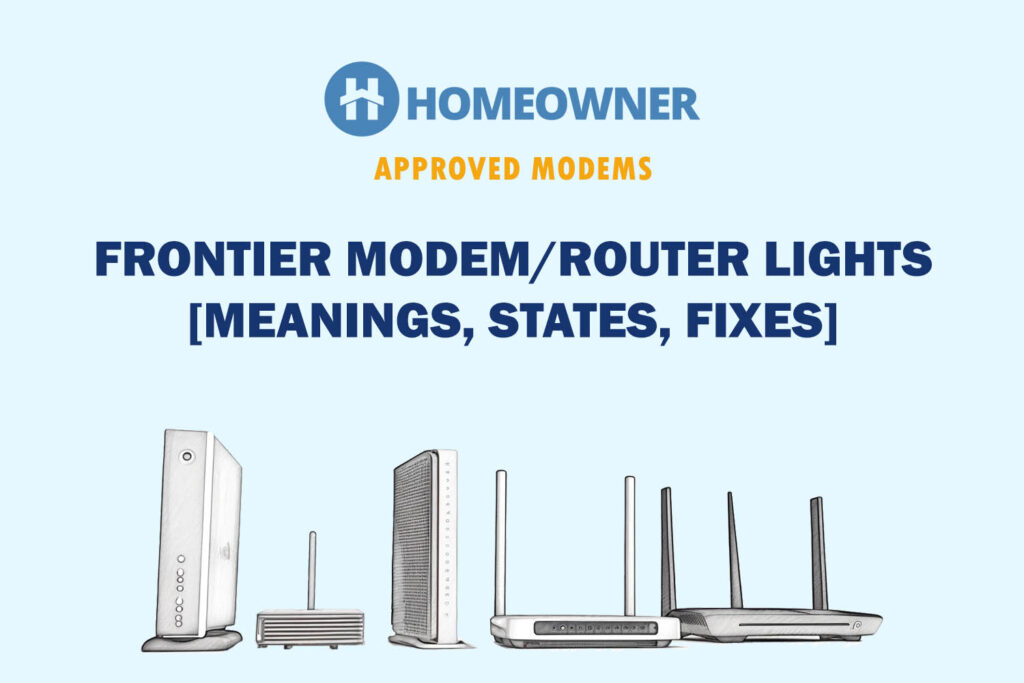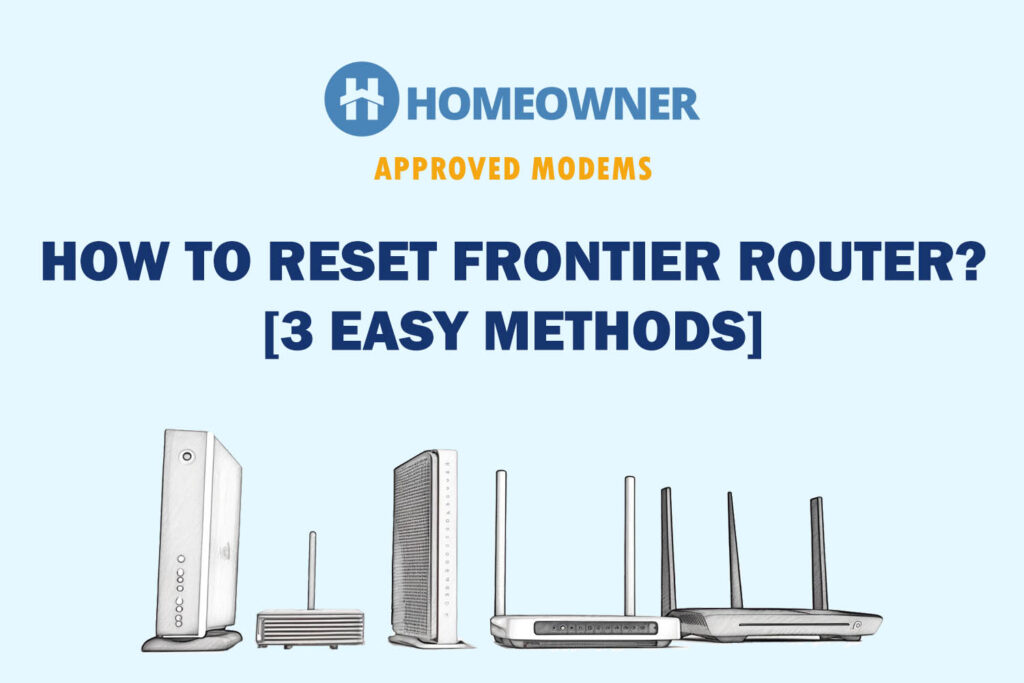In this post:
- 1. Best Overall: Netgear Nighthawk RAXE500
- 2. Best Runner-Up: TP-Link Archer AX90
- 3. Best for Gaming: ASUS RT-AX86S
- 4. Best Mesh WiFi System: TP-Link Deco XE75
- 5. Best for Streaming: Netgear Nighthawk RAX43
- 6. Best Value: Linksys Hydra Pro 6
- 7. Cheapest Option: ASUS RT-AX55
- Frequently Asked Questions
- Verdict
Have you recently set up the Frontier connection yet aren't satisfied with the performance of the Frontier FiOS router? Well, you can buy your own router for Frontier FiOS, as not only will it offer you desired speeds and coverage, and it will also handle more devices and offer you a ton of customization.
But then, you won’t get any official list of Frontier-compatible routers. And with the market filled with quality options, finding an ideal device becomes challenging. Fret not. After four weeks of research and testing 13 devices, I recommend the 7 best options for 2025.
- Best Overall: Netgear RAXE500
- Best Runner-Up: TP-Link AX90
- Best Gaming Router: ASUS RT-AX86S
- Best Mesh WiFi: TP-Link Deco XE75
- Best For Streaming: Netgear RAX43
- Best Value: Linksys Hydra Pro 6
- A Good Cheap Option: ASUS RT-AX55
How Did I Prepare This List?
To ensure you get the best, I bought 13 popular routers that work with Frontier and paired them with a model-appropriate FiOS plan. Then, I observed each model for 3 days against multiple aspects that dictate their overall performance.
And based on test results, I have only included models that boost your FiOS connection's WiFi signal and internet speed. I've also prioritized devices that ensure network stability and security.
Overview of List: The list includes the best available wireless routers in their price segment and pairs well with Frontier FiOS service packages. It starts with a high-end premium model and ends with a $55 budget option. So, feel free to browse through them all.
1. Best Overall: Netgear Nighthawk RAXE500

- Wireless Standard: Wi-Fi 6E
- Suitable Plan: Fiber 2 Gig
- 2.4GHz Speeds: 1.2 Gbps
- 5GHz Speeds: 4.8 Gbps
- 6GHz Speeds: 4.8 Mbps
- WiFi Range: Up to 3,500 Sq Ft
- Number of Devices Supported: 60
- Ports: 1 x WAN + 4 x LAN + 1 x 2.5 G + 2 x USB 3.0
- Processor: 1.8GHz Quad-Core Processor
- RAM & NAND Memory: 1GB + 512MB
- App Support: Yes
Netgear RAXE500 is one of the most premium Wi-Fi 6E routers that's a network powerhouse. With beautiful aesthetics, no protruding antennas, simple installation, and reliable firmware, this router brings a lot to the table. Considering the high-end spec sheet and performance it delivers, it’s a powerful upgrade to its predecessor, RAXE7800.
Why is it suited for Frontier FiOS?
I put RAXE7800 through a series of usual throughput tests, starting with its wireless capabilities. Testing on it with FiOS 2 Gig plan got me excellent speeds. Its 6GHz band was the fastest, courtesy of minimal interferences and availability of a multitude of channels.
The download speeds on my iPhone 13 averaged 1.8 Gbps, while the upload speeds were around 545 Mbps. Besides that, the router turned out excellent on my 5GHz and 2.4GHz performance tests. Its 1.5 Gbps download speeds on 5GHz, and 865 Mbps on 2.4GHz turned out to be one of the fastest around here.
So, whichever band you connect to, you are bound to get speeds that allow you to carry out various tasks like gaming, 4K streaming, video conferencing, and others.
Wired Speed
Aside from a usual setup of 5 Gigabit Ethernet ports, a 2.5 Gbps WAN port lets you experience multi-gigs of internet speeds. The speed test results on iPhone 13 were 2100 Mbps and 654 Mbps for downloads and uploads. So, you will surely receive an unmatched throughput performance with this futuristic router.
WiFi Coverage & Connections Capacity
WiFi coverage is also a strong suit of this Wi-Fi 6e router. It integrates 6 internally positioned antennas and proprietary optimization to deliver more reliable and stronger connections and minimal interference to your connected devices.
Considering the maximum range to be 3,500 Sq Ft, I tested this RAXE7800 at a 2,500 Sq Ft test center, and the network worked fine in every corner. Also, security cameras outside the center received a two-bar Wi-Fi signal. So, in a real-life setting, the maximum this device can sheath would be around 3,000 Sq Ft, making it suitable for large homes and workspaces.
Besides, integrating technologies like QoS prioritization and MU-MIMO lets you experience a lag-free connection on all your devices, irrespective of location.
Security Features
The RAXE500 has certain security features, but I was disappointed that it comes at an additional charge, despite mentioning “built-in” on the router. After a 30-day trial period, paying $69.99 yearly gives you access to advanced features like weekly network scans, firewalls, VPNs, and blocking malicious websites.
Nevertheless, there are some basic features like WPA3 encryption, and basic security scans, which I reckon are sufficient for residential settings. And the unpaid parental controls include monitoring online time and pausing WiFi at any time.
Conclusion
With such a high-end spec sheet, RAXE500 is undoubtedly the best WiFi router for Frontier FiOS. It doesn't disappoint a tad. Its wireless and wired capabilities are exceptional, and you can expect its high-performance antennas to sheath your space with a strong connection. However, at such a premium price, I have hoped for more security features for free.
Want to know more about Nighthawk RAXE500? Read the full review.
Pros
- Tri-band, with 6 GHz speed
- Supports link aggregation
- Lightning fast speeds
- Exceptional coverage
- 2.5 Gbps Ethernet
Cons
- Premium
- Security costs extra
2. Best Runner-Up: TP-Link Archer AX90
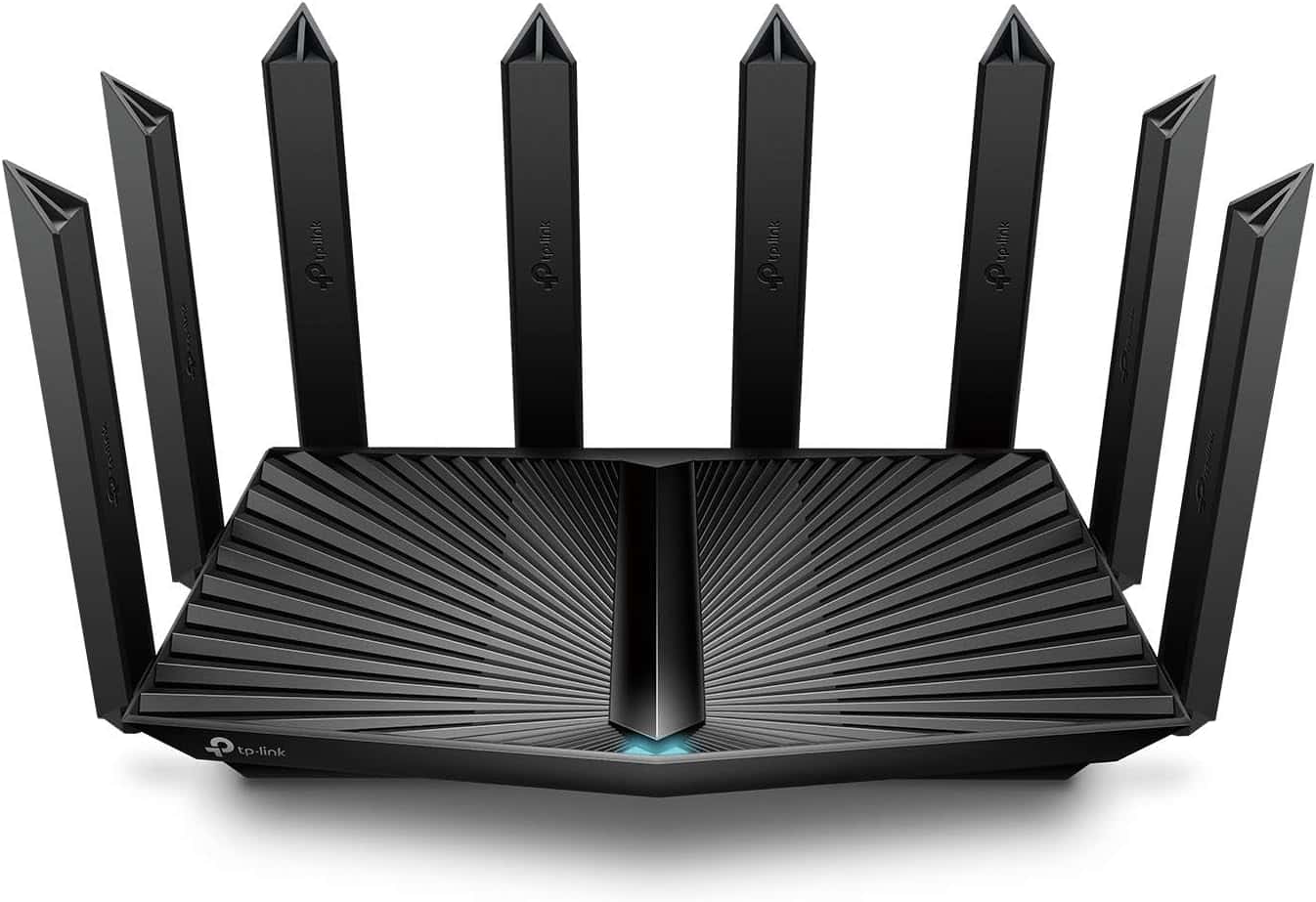
- Wireless Standard: Wi-Fi 6 (802.11ax)
- Suitable Plan: Fiber 2 Gig
- 2.4GHz Speeds: 574 Mbps
- 5GHz Speeds: 4804 + 1201 Mbps
- WiFi Range: Up to 2,500 Sq Ft
- Number of Devices Supported: 40+
- Ports: 1 x WAN + 4 x LAN + 1 x USB 3.1
- Processor: 1.5GHz Quad-Core
- RAM & NAND Memory: 512MB + 128MB
- App Support: Yes
Here’s another tri-band router that boasts some major upgrades to TP-Link’s flagship model, Archer AX73. Some notable ones include a 5GHz band, more antennas, an additional 2.5G WAN port, and many more. But despite its long spec sheet, does it delivers? Let’s see.
Why is it suited for Frontier FiOS?
Being a tri-band Wi-Fi 6 router, there is a visible speed boost over Archer AX73 when paired with FiOS 2 Gbps plan. Measuring on the additional 5GHz band, download speeds raked up to 1.7 Gbps, while upload speeds measured to 510 Mbps. At the same time, the other 5GHz band had respective speeds of 1.1 Gbps and 325 Mbps for downloads and uploads.
Along with these, the 2.4GHz, better known for expanding range, also delivered decent speeds. On my Dell laptop, I could download Call of duty vanguard on my Dell laptop at 535 Mbps, and it took me around an hour to complete. On the other hand, I uploaded my presentations over dropbox at 154 Mbps.
So, in short, courtesy of an additional band, it’s safe to say the router is ridiculously quick. And with such bandwidth, you can download 10GB of files in less than a minute.
Wired Speed
The router has more to offer if you are hungry for even more. Its 2.5G WAN port is a major upgrade over AX73, allowing you to experience multi-gigs of speeds, which was the case when I plugged in my Dell laptop. The respective download and upload speeds raked up to 2 Gbps and 600 Mbps, much higher than I got connected on WiFi.
WiFi Coverage & Connections Capacity
Despite featuring 8 antennas, its coverage lacks a bit compared to the 6-antenna setup of my previous recommendation. The router performed extremely well in my 1,500 Sq Ft home office. Besides covering the entire workspace, I also received signals in my bedroom. So, on average, covering 2,000 Sq Ft should be a cakewalk.
Now resting on connections capacity, technologies like beamforming, QoS, and MU-MIMO does the magic. It concentrates all the signals to send to a connected device. So, your 25 devices continue receiving faster throughput wherever you are in the space.
Security Features
Out of the box, Archer AX90 boasts the latest WPA3 security, which brings a lot of upgrades to WPA2, like password secrecy, ease of use, and natural password selection. Also, there are some basic parental controls to keep track of your kids’ online time and pause if they’re spending too much there.
Besides, a TP-Link Homeshield feature powered by Avira comes at a $54.99 yearly subscription. It blocks malware or virus-infected websites from being accessed, and your connected devices now have an additional level of network security. Besides, it provides a weekly scan report, mentioning the detected threats.
Conclusion
All in all, Archer AX90 is a powerful and feature-packed device that’s compatible with any Frontier FiOS plan. The device also has many other advanced features to let you enjoy internet connections with peace. The only drawback is its price, which is justified considering its features.
Pros
- Multi-gig WAN/LAN
- Consistent throughput
- Solid performance
- Decent coverage
- Handles 40+ devices
Cons
- Expensive
- Some features require a subscription
3. Best for Gaming: ASUS RT-AX86S
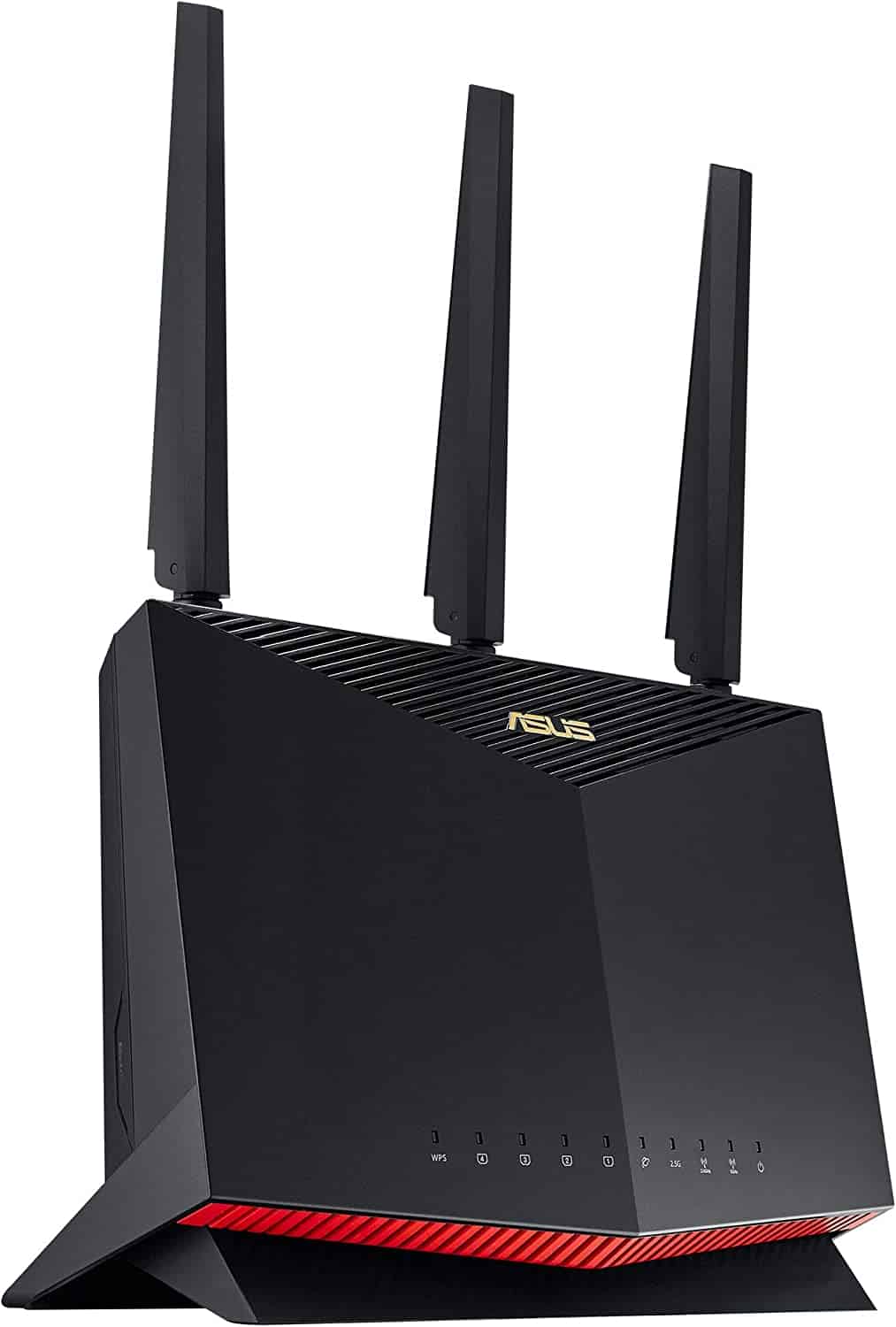
- Wireless Standard: Wi-Fi 6 (802.11ax)
- Suitable Plan: Fiber 2 Gig
- 2.4GHz Speeds: 861 Mbps
- 5GHz Speeds: 4804 Mbps
- WiFi Range: Up to 2,500 Sq Ft
- Number of Devices Supported: 100+
- Ports: 1 x WAN + 4 x LAN + 1 x USB 3.2 + 1 x USB 2.0
- Processor: 1.8GHz Quad-Core
- RAM & NAND Memory: 512MB + 256MB
- App Support: Yes
Presenting next is a gaming router, ASUS RT-AX86S, which boasts a Wi-Fi 6 standard, so expect faster speeds, lower latency, longer range, and energy efficiency.
You will find many gaming-centric specifications like NAT port forwarding and device prioritization alongside OFDMA and 1024-QAM to deliver lower ping. Pair it with a gaming-friendly modem and you're ready to rock!
Why is it suited for Frontier FiOS?
Asus RT-AX86S stands tall to its tag of gaming router in my throughput tests. Considering its maximum throughput capacity of 5.7 Gbps, I paired a 2 Gig plan, and the speed output on both bands was excellent.
On the 5GHz band, download speeds raked at 1.5 Gbps, while upload speeds were around 505 Mbps, while respective speeds on the other band were 500 Mbps and 130 Mbps. Such speeds allowed me to get all my pending downloads done within a few minutes, alongside playing online games and streaming 4K content.
Wired Speed
Although it didn’t boast a 2.5 Gig internet connection, 5 Gigabit Ethernet ports compensate for it a bit. You can plug in any networking device to experience a maximum download speed of 1.8 Gbps while uploading at 550 Mbps. I connected my gaming consoles and played Valorant on it for hours without lags or latencies.
WiFi Coverage & Connections Capacity
The RT-AX86S performed well in my coverage tests. Despite featuring 3 antennas, it could easily sheath my grandpa's 1,800 Sq Ft old house. They've been using this router for quite some time and have never heard any complaints regarding a weak network spot or dead zone, and I also found frailing signals in his garage.
Technologies such as OFDMA and beamforming increase the number of devices from 15 in the previous model to 40 in this one. And the signals were consistent throughout the day.
Security Features
You get a lifetime free subscription to commercial-grade security, AiProtection Pro. Featurewise, it isn’t as advanced as Homeshield, but features like firewalls, WPA3, and parental controls don’t keep you very far behind. Besides, it doesn’t cost you a penny, and you can monitor what’s going on with your network through the mobile app.
Conclusion
To sum up, RT-AX86S is a superlative choice for online gamers seeking to remove network bottlenecks. Integration of some powerful upgrades takes its performance to a whole new level, and you can play any online game with peace of mind. However, the lack of an additional band and a 2.5G port pushes it down to the third position.
Pros
- Fast close-range speed
- Consistent throughput
- Dedicated gaming port
- Excellent WiFi coverage
- Lifetime free security
Cons
- Not a tri-band router
4. Best Mesh WiFi System: TP-Link Deco XE75
Do you live in a 2-3 story house with many WiFi dead zones? You're better off investing in TP-Link's Deco XE75, one of the best mesh WiFi systems of 2025.
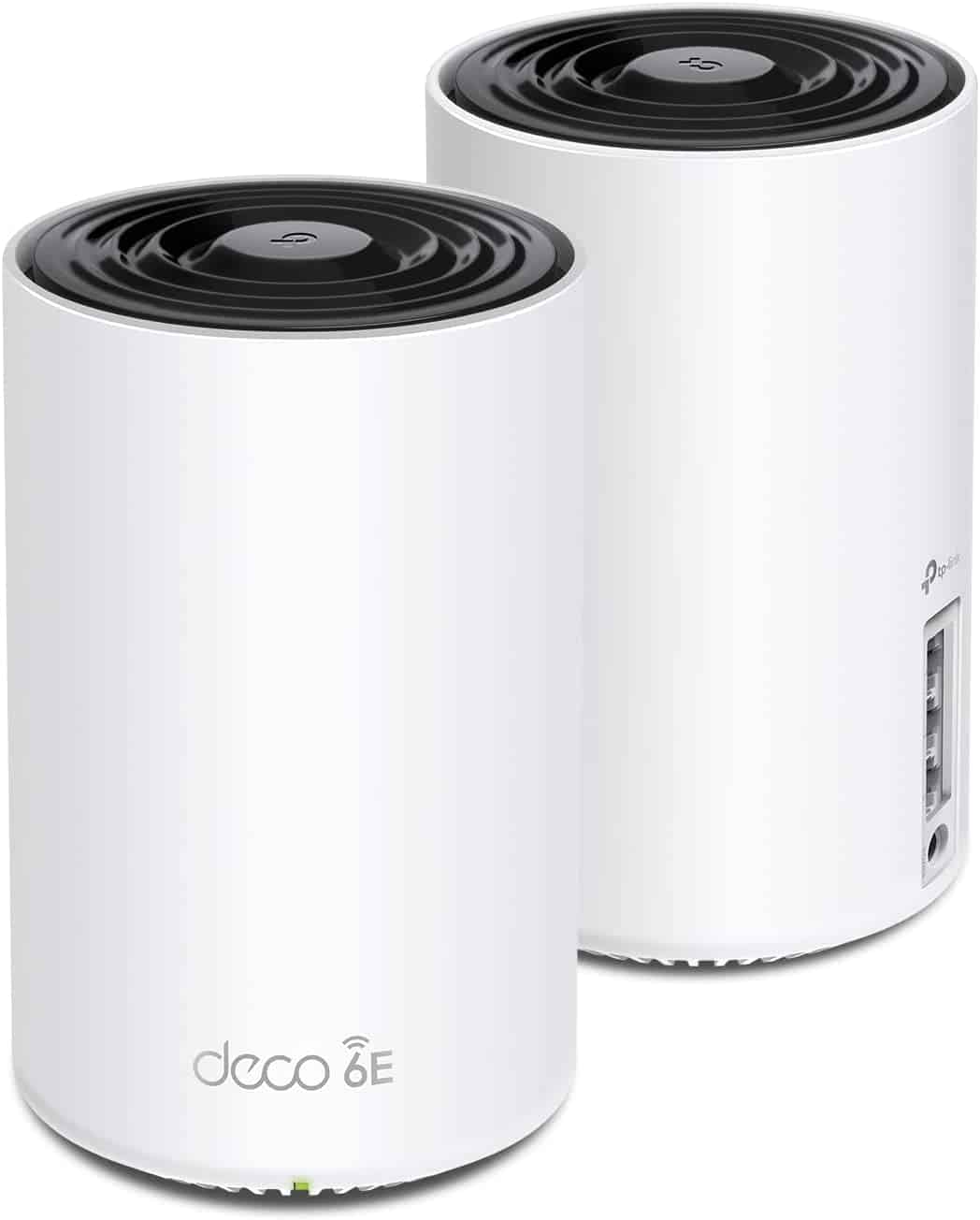
- Wireless Standard: Wi-Fi 6E (802.11ax)
- Suitable Plan: Fiber Gig
- 2.4GHz Speeds: 574 Mbps
- 5GHz Speeds: 2402 Mbps
- 6GHz Speeds: 2402 Mbps
- WiFi Range: Up to 5.500 Sq Ft
- Number of Devices Supported: 200
- Ports: 6 x Ethernet
- Processor: 1.7GHz Quad-Core
- RAM & NAND Memory: 512MB + N/A
- App Support: Yes
If you’re looking for a Wi-Fi 6e mesh router with Frontier FiOS, TP-Link Deco XE75 is worth a look. The new 6GHz band makes it one of the fastest routers out there. It combines with powerful hardware and other technologies to deliver a much better performance than its predecessor, Deco X60.
Why is it suited for Frontier FiOS?
When testing its throughput with my Dell laptop over a short distance, it easily clocked download speeds of over 950 Mbps with a Gig plan, which surpasses its predecessor. With the 6GHz band, there wasn’t much drop in download speeds over a large distance, valued at around 850 Mbps. The upload speeds on respective distances were 450 Mbps and 350 Mbps.
The other two bands also performed decently well in my throughput tests. Testing in a similar setup, download speeds on 5GHz and 2.4GHz bands were 767 Mbps and 484 Mbps, while 215 Mbps and 125 Mbps were the upload speeds. In terms of speeds, Deco XE75 even surpassed its costly variant, Deco X90.
Wired Speed
The XE75 mesh integrates 3 Ethernet ports on each unit but lacks a 2.5G WAN port, as in its successor, i.e., Deco XE75 Pro. With it, you can take your speeds to new heights, valuing up to 1011 Mbps and 525 Mbps for downloads and uploads. So, you can connect your gaming consoles or other devices to exploit its high speeds.
WiFi Coverage & Connections Capacity
Being a mesh system, I had a lot of expectations from it in terms of coverage, and its 4 high-gain internal antennas didn’t let me down. Multiple antennas work harmoniously to sheath an area of up to 5,500 Sq Ft, so there were no weak or dead network spots left in my 3,700 Sq Ft home. The signals were also there in my garden and garage.
Besides, the roaming capability of this router is its strongest selling point. Coming with an 802.11k/v/r fast roaming technology driven by an AI-roaming algorithm makes sure you always stay connected. When testing on my iPhone 13, I didn’t notice any dropouts or freezes, even when I roamed around my space.
Besides, I connected around 25 available devices to carry out various tasks like gaming, 4K video streaming, video conferencing, and others without any lags. Technologies like MU-MIMO, OFDMA, and QoS made this possible. You can connect even more devices, considering its maximum connection capacity to be 200 devices.
Security Features
Deco XE75 supports the latest WPA3 security on all its three bands to encrypt the data shared over the network, thereby keeping it safe. Its VPN-passthrough feature also comes right out of the box, which lets you browse anything by keeping yourself anonymous. Besides, like all TP-Link devices, there’s Homeshield up for grabs.
Conclusion
In conclusion, Deco XE75 is one of the most affordable WiFi 6e mesh systems with multiple ethernet ports. The new 6GHz band provides you with more usable signals and, thereby, greater throughput. Alongside, coverage is its strong suit. However, the lack of a 2.5G WAN port and lesser maximum throughput capacity has pushed it down the list.
For more information, read my full review of the Deco XE75.
Pros
- Wi-Fi 6E support
- Tri-Band operation
- Great wireless coverage
- QoS and MU-MIMO
- Supports up to 200 devices
- Multiple ethernet ports
Cons
- No 2.5G port
- Security features need a subscription
5. Best for Streaming: Netgear Nighthawk RAX43
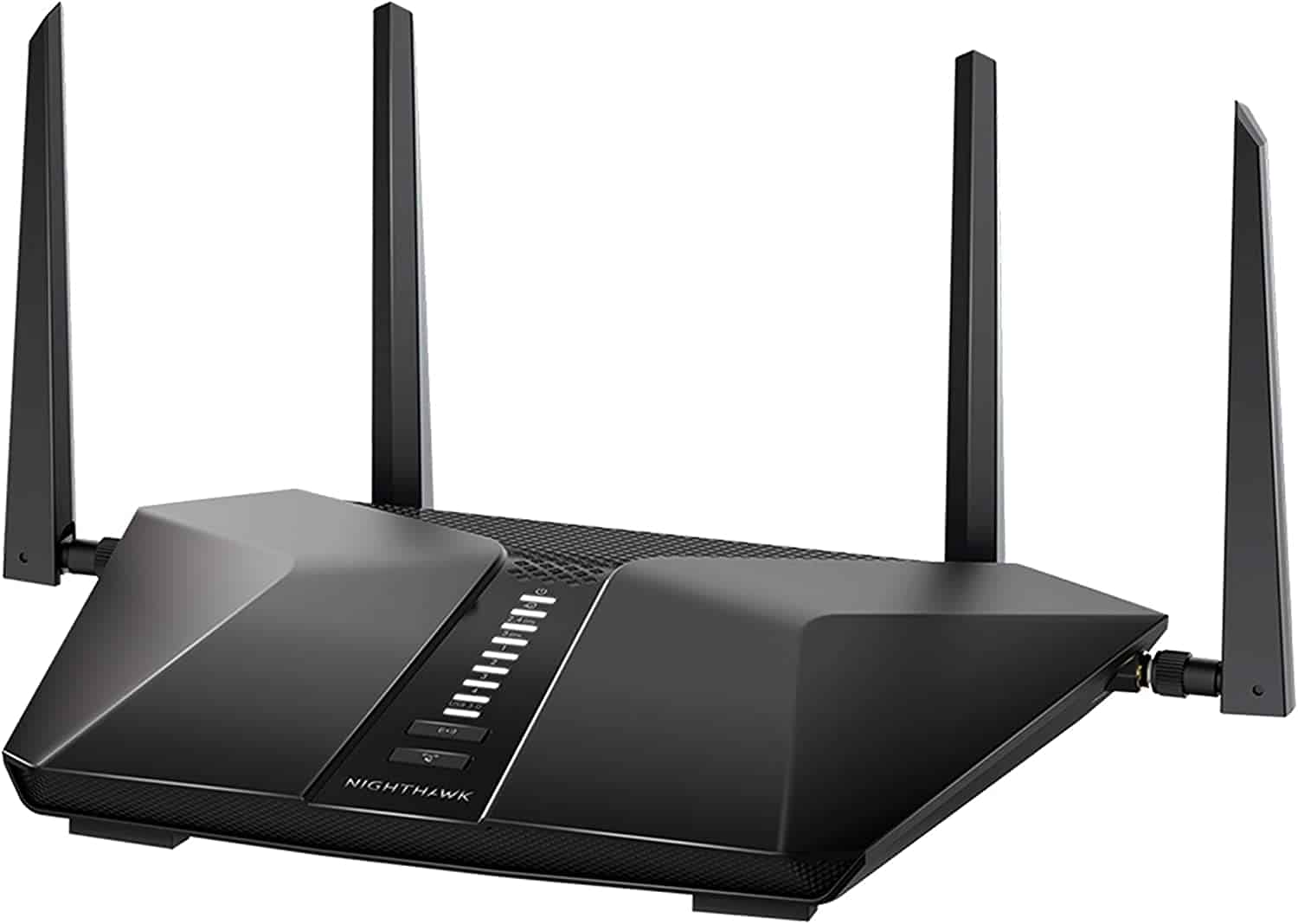
- Wireless Standard: Wi-Fi 6 (802.11ax)
- Suitable Plan: Fiber Gig
- 2.4GHz Speeds: 574 Mbps
- 5GHz Speeds: 3603 Mbps
- WiFi Range: Up to 2,500 Sq Ft
- Number of Devices Supported: 25
- Ports: 4 x LANs + 1 x WAN + 1 x USB 3.0
- Processor: 1.5GHz Triple-Core
- RAM & NAND Memory: 512MB + 256MB
- App Support: Yes
Netgear Nighthawk RAX43 is a mid-range router that outperforms the Nighthawk RAX40 in terms of speed, throughput, and coverage. The device, which has sharp corners and a black matte finish, resembles a spaceship. Furthermore, there have been advancements in terms of features that make it a more appealing option.
Why is it suited for Frontier FiOS?
If you are subscribed to a Frontier FiOS plan below 1 Gbps, including Fiber or DSL, then Nighthawk RAX43 might be all you need. It offers performance much higher than its price point, clocking an impressive 915 Mbps in the 5GHz band at 5 feet. While taking the device 20-25 feet away from the router, I could still get 651 Mbps.
That’s all about download speeds on the 5GHz band. The upload speeds clocked at 420 Mbps and 300 Mbps at similar ranges, respectively. On the other hand, respective download and upload speeds for the 2.4GHz band were 475 Mbps and 215 Mbps, respectively.
That’s adequate for covering the bandwidth needs of most traditional households and small workspaces, i.e., 8-9 people streaming movies, playing games, and browsing simultaneously.
Wired Speed
Now in my throughput tests for wired speeds, my iPhone 13 clocked download and upload speeds at 995 Mbps and 500 Mbps, respectively. That’s higher than wireless speeds, providing you with opportunities to explore more.
WiFi Coverage & Connections Capacity
The router also played out fairly well in my coverage tests. Boasting 4 external antennas, its maximum range can extend up to 2,500 Sq Ft. So any mid-sized apartment or a small workspace should be adequate for its installation.
Besides, you can connect up to 15 devices simultaneously without dipping the speeds by a tad, courtesy of technologies like beamforming, MU-MIMO, and OFDMA.
Security Features
The company doesn’t offer much for free, except WPA3 and VPN-passthrough. And you need to pay a monthly subscription fee if you want to upgrade the security. Antivirus and parental controls are paid, but it does work very hard to keep any external threats away from your home network, which makes Netgear Armor a worthy addition.
Conclusion
Overall, Netgear RAX43 comes with some reliable features that can fulfill most of your residential or commercial networking needs. So whether you’re a streamer, gamer, or just a regular employee sending excel over emails or attending video calls, this can be a handy device to have. But, the lack of MU-MIMO and QoS takes it to the fifth position.
Pros
- Enough WiFi range
- Security features are reliable
- Decent speeds and coverage
- Easy to setup and use
- Powerful hardware
Cons
- Lacks MU-MIMO & QoS
- Security features are paid
6. Best Value: Linksys Hydra Pro 6
- WIFI ROUTER FOR HIGH SPEED - Take work and play to the next level with higher speeds and wider coverage in every corner of your home. Equipped with Intelligent Mesh, this dual-band router delivers the true power of WiFi 6 technology
- MAKE THE MOST OF YOUR WIFI CONNECTION - Access to higher bandwidth limits enables the true power of WiFi 6 technology, delivering the fastest connection with everything you do
- MORE WIFI FOR MORE DEVICES - WiFi 6 sends and receives multiple streams of data simultaneously, providing up to 4x more WiFi capacity to handle more gaming, and smart home devices
- POWERFUL MESH TECHNOLOGY - Future-ready hardware with Cognitive Mesh Technology and guaranteed updates keep your connection going strong
- SIMPLE SETUP: The browser-based setup provides clear visual instructions of the entire process so you can get online in minutes. Set separate guest access to keep the network safe.
The Linksys Hydra Pro 6 is one of the better budget-friendly routers to pair with Frontier Fiber. It supports WiFi 6 and reaches up to 5400 Mbps across its dual bands, with 160 MHz channel support and solid real-world performance. While it doesn’t come with multi-gig ports or advanced QoS settings, it still performs well for households that stream, game, and browse all at once. It’s a simple router that gets the job done for small to medium homes without added complexity.
In testing with a Frontier 500 Mbps fiber connection, the Hydra Pro 6 delivered consistent speeds, low latency, and stable coverage across two floors. It also supports mesh expansion through Linksys Intelligent Mesh, so if you ever need more range, it’s easy to add a second unit later. For everyday use and a wide range of devices, it’s a solid choice for users who want strong performance without spending extra.
Why is it suited for Frontier FiOS?
Frontier Fiber doesn’t use a traditional modem, so most third-party routers connect directly to the ONT using a standard Ethernet WAN port. The Hydra Pro 6 includes a 1 Gbps WAN port and worked right away during testing—no need for extra setup or firmware tweaks. It handled Frontier’s 500 Mbps tier without issues and maintained steady speeds and a responsive connection during high-use periods.
There’s no support for multi-gig plans, so if you’re on Frontier’s 2 Gbps or 5 Gbps tiers, this won’t give you full speed. But if you’re on any of the entry or mid-tier plans (500 Mbps or 1 Gbps), the Hydra Pro 6 performs well and doesn’t require any advanced configuration to pair with Frontier’s service.
Wired Speed
The router has four Gigabit LAN ports on the back, which is useful if you want to hardwire devices like gaming consoles, streaming boxes, or desktop PCs. On Frontier’s 500 Mbps plan, I ran speed tests using a wired PC and consistently hit 510–520 Mbps down and just under 500 Mbps up.
Ping times during online gaming and video calls stayed low and stable. Game updates, large file transfers, and 4K video streams ran without delay. While there’s no multi-gig or link aggregation support, the existing ports are enough for most home setups using Frontier’s more common speed tiers.
WiFi Coverage & Connections Capacity
The Hydra Pro 6 covered around 2,300 square feet in a two-story home during testing. Signal stayed strong across both floors and even extended into the garage. It has two internal antennas and supports beamforming, MU-MIMO, and OFDMA, which help maintain strong connections even with multiple devices running at the same time.
I had 26 devices connected while testing—including smart TVs, phones, laptops, and a gaming console—and didn’t notice any slowdowns. Wireless speeds stayed consistent across rooms, and the 5 GHz band handled most of the heavy traffic. For homes that don’t need wall-to-wall mesh coverage, this router handles everyday use with no problem.
If you do need more range later, it’s mesh-compatible with other Linksys devices, which makes it easy to expand coverage without buying a new system.
Security Features
The Hydra Pro 6 includes WPA3 encryption, a built-in firewall, and basic parental controls in the Linksys app. You can pause WiFi for specific devices, set up guest access, and manage connections from your phone. The app also lets you monitor usage, apply firmware updates, and check on connected devices.
There’s no subscription-based security platform like Netgear Armor or TP-Link HomeShield, but the included features cover the basics most households need. Setup is simple, and most controls are available without having to log into a web browser.
Conclusion
For Frontier Fiber users on a 500 Mbps or 1 Gbps plan, the Linksys Hydra Pro 6 delivers fast performance without extra cost or complexity. It’s fast enough for most households, easy to set up, and handles dozens of devices without slowing down. You won’t find multi-gig ports or advanced traffic controls, but the basics are strong.
Pros
- Consistent performance with Frontier Fiber
Handles 35+ connected devices smoothly
Mesh support for easy expansion
Simple app controls
Cons
- No multi-gig ports
No advanced QoS or security features
Coverage may be limited for large homes without mesh
7. Cheapest Option: ASUS RT-AX55
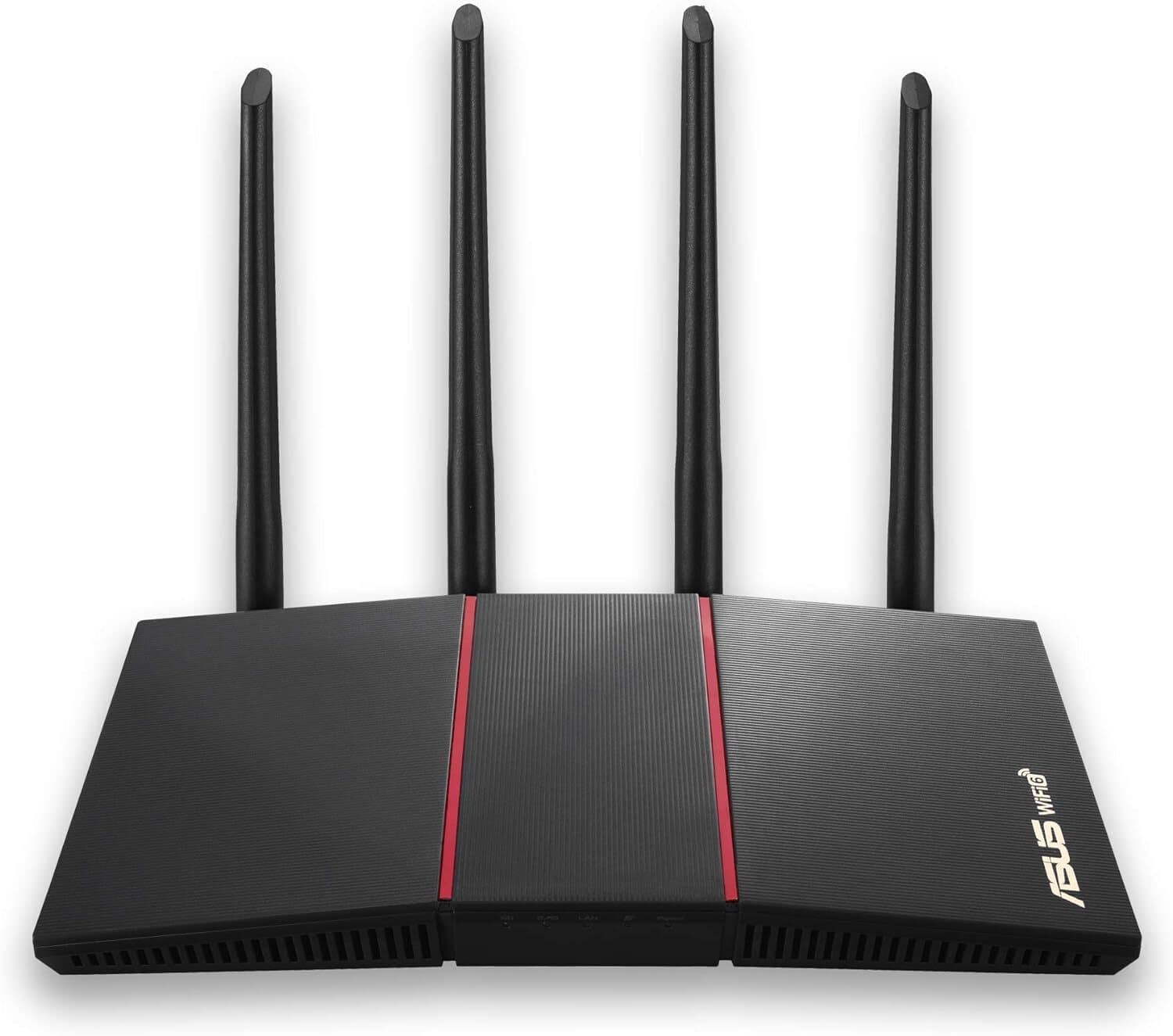
- Wireless Standard: Wi-Fi 6 (802.11ax)
- WiFi Range: Up to 3,000 Sq Ft
- Devices Capacity: Up to 30
- Band Frequency: Dual-Band
- Ports: 1 x Gig-E WAN + 4 x Gig-E LAN
The ASUS RT-AX55 is a budget WiFi 6 router that works well with entry-level Frontier Fiber plans like 300 Mbps. It offers AX1800 speeds with 1201 Mbps on the 5 GHz band and 574 Mbps on the 2.4 GHz band. It doesn’t include multi-gig ports or advanced controls, but it covers small homes with fast, steady WiFi. During testing with Frontier’s 300 Mbps plan, it delivered full speed across multiple devices with no issues.
The design is simple, and setup through the ASUS app took less than 10 minutes. This router works well for families or individuals who don’t need high-end hardware but still want a modern upgrade with WiFi 6 support. It’s a very good option if you’re trying to keep costs down while moving to fiber.
Why is it suited for Frontier FiOS?
Frontier Fiber doesn’t require a modem, so I connected the RT-AX55 directly to the ONT using the WAN port. No extra steps or configuration were needed. On the 300 Mbps plan, download speeds consistently stayed between 290–310 Mbps, and uploads hit 20 Mbps. The router handled online meetings, streaming, and browsing without slowing down.
This router works best with Frontier’s 300 Mbps or 500 Mbps plans. It doesn’t support multi-gig speeds, so it isn’t a match for the 2 GIG or 5 GIG tiers. But for the base plan, it performs well and stays reliable under everyday use.
Wired Speed
The ASUS RT-AX55 includes one Gigabit WAN port and four Gigabit LAN ports. I tested it with a wired desktop and gaming console on Frontier’s 300 Mbps fiber plan. Both reached full download and upload speeds without delays. File transfers were quick, and ping stayed low during online gaming. There’s no multi-gig support, but for 300 or 500 Mbps service, the wired ports provide full speed with no issues.
WiFi Coverage & Connections Capacity
Coverage reached about 2,300 square feet in testing. The signal stayed strong in every room of a small single-story home, including the backyard. The four external antennas and beamforming helped keep the signal stable through walls. For apartments or mid-sized houses, this range is enough on its own.
I tested 18 connected devices, including smart TVs, tablets, phones, laptops, and smart home gear. The router handled all of them without drops. MU-MIMO and OFDMA helped distribute traffic efficiently. Even with several devices streaming video or downloading files, the connection stayed responsive.
Security Features
The RT-AX55 includes basic WPA3 encryption and ASUS AiProtection Classic. It blocks known malicious sites and alerts you to possible infected devices. Parental controls let you block content, set schedules, and pause access on specific devices.
All settings are managed through the ASUS Router app. It gives you control over guest networks, firmware updates, and connected device monitoring. There’s no subscription required for these tools, and they’re easy to access and adjust.
Conclusion
If you're using Frontier Fiber’s 300 Mbps plan and want something affordable, the ASUS RT-AX55 is a very good option. It keeps speeds consistent, supports WiFi 6, and offers enough range for most small homes. While it skips high-end features, it covers the basics well.
Pros
- Affordability
- Easy-to-use app
- Long WiFi range
- Lifetime free security
- Reliable performance
Cons
- No USB port
- Speed drops over a distance
Frequently Asked Questions
Frontier provides its customers without charging anything and renting a router costs around $10 a month, which is baked on top of the advertised monthly rate. It uses routers from various reputed brands like Greenwave, Netgear, and D-Link, amongst others. So rather than charging an upfront fee, you must pay a monthly rental fee.
Yes, you can. Unlike cable modems, there’s no ISP compatibility factor associated with the WiFi routers, and you can pair any third-party device with it. Just make sure the hardware specifications and associated technologies are effective enough to pan out well with your subscribed Frontier internet plan.
Yes, considering the outdated features you get in the ISP-rented router, you’re better off purchasing your own router. You can select from my curated list of options or do your research to purchase a router that suits your needs and budget.
Selecting an ideal Frontier FiOS-compatible router is no rocket science. You need to keep a few things a mind, which include:
– One that fits well into your budget
– Works well with your subscribed Frontier FiOS plan
– Offers a decent coverage
– Other features include security, parental controls, and technologies like MU-MIMO, beamforming.
Verdict
Frontier offers many plans, ranging from slow and basic to blazing fast yop-notch speeds. Your selected Frontier FiOS router should be capable of delivering the most out of your plan and should run your tasks without any issues.
I hope my curated list helps you get your hands on the best-suited router, but if you are still confused, here are a few of the top options:
- If you’re subscribed to the highest-speed plan and need a device with high-end features, Netgear RAXE500 with Wi-Fi 6E support should be your best bet. It combines high-end features with the latest technology to let you experience blazing-fast speeds and throughout.
- If budget is an issue, and you are looking for a router with almost similar output, Asus RT-AX86S comes at half the cost. It ingrains some powerful features that take your internet usage experience to a new level.
- Finally, if you want a cheaper option, go for Linksys EA8100. You might not get the fastest speeds with this, but it can surely cover your 1,800 Sq Ft house with strong signals.
With that, I'd like to wrap up this article. I hope I've addressed all of your concerns!





